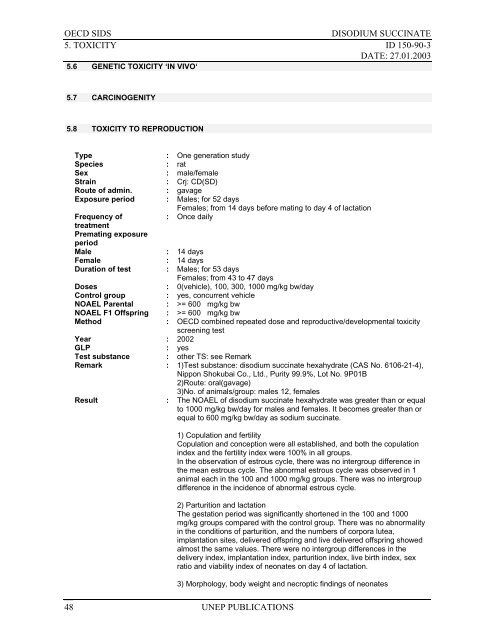DISODIUM SUCCINATE CAS N°: 150-90-3
DISODIUM SUCCINATE CAS N°: 150-90-3
DISODIUM SUCCINATE CAS N°: 150-90-3
You also want an ePaper? Increase the reach of your titles
YUMPU automatically turns print PDFs into web optimized ePapers that Google loves.
OECD SIDS<br />
<strong>DISODIUM</strong> <strong>SUCCINATE</strong><br />
5. TOXICITY ID <strong>150</strong>-<strong>90</strong>-3<br />
DATE: 27.01.2003<br />
5.6 GENETIC TOXICITY ‘IN VIVO‘<br />
5.7 CARCINOGENITY<br />
5.8 TOXICITY TO REPRODUCTION<br />
Type : One generation study<br />
Species : rat<br />
Sex : male/female<br />
Strain : Crj: CD(SD)<br />
Route of admin. : gavage<br />
Exposure period : Males; for 52 days<br />
Females; from 14 days before mating to day 4 of lactation<br />
Frequency of<br />
: Once daily<br />
treatment<br />
Premating exposure<br />
period<br />
Male : 14 days<br />
Female : 14 days<br />
Duration of test : Males; for 53 days<br />
Females; from 43 to 47 days<br />
Doses : 0(vehicle), 100, 300, 1000 mg/kg bw/day<br />
Control group : yes, concurrent vehicle<br />
NOAEL Parental : >= 600 mg/kg bw<br />
NOAEL F1 Offspring : >= 600 mg/kg bw<br />
Method : OECD combined repeated dose and reproductive/developmental toxicity<br />
screening test<br />
Year : 2002<br />
GLP : yes<br />
Test substance : other TS: see Remark<br />
Remark : 1)Test substance: disodium succinate hexahydrate (<strong>CAS</strong> No. 6106-21-4),<br />
Nippon Shokubai Co., Ltd., Purity 99.9%, Lot No. 9P01B<br />
2)Route: oral(gavage)<br />
3)No. of animals/group: males 12, females<br />
Result : The NOAEL of disodium succinate hexahydrate was greater than or equal<br />
to 1000 mg/kg bw/day for males and females. It becomes greater than or<br />
equal to 600 mg/kg bw/day as sodium succinate.<br />
1) Copulation and fertility<br />
Copulation and conception were all established, and both the copulation<br />
index and the fertility index were 100% in all groups.<br />
In the observation of estrous cycle, there was no intergroup difference in<br />
the mean estrous cycle. The abnormal estrous cycle was observed in 1<br />
animal each in the 100 and 1000 mg/kg groups. There was no intergroup<br />
difference in the incidence of abnormal estrous cycle.<br />
2) Parturition and lactation<br />
The gestation period was significantly shortened in the 100 and 1000<br />
mg/kg groups compared with the control group. There was no abnormality<br />
in the conditions of parturition, and the numbers of corpora lutea,<br />
implantation sites, delivered offspring and live delivered offspring showed<br />
almost the same values. There were no intergroup differences in the<br />
delivery index, implantation index, parturition index, live birth index, sex<br />
ratio and viability index of neonates on day 4 of lactation.<br />
3) Morphology, body weight and necroptic findings of neonates<br />
48<br />
UNEP PUBLICATIONS
















